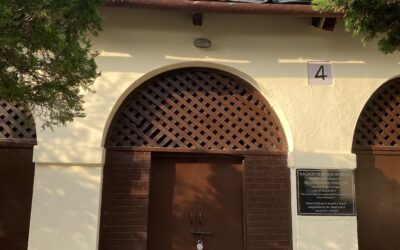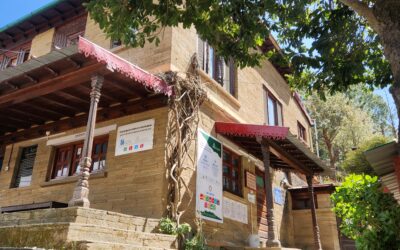It’s a flower. A flower unlike anything you and I have ever seen. Within it something white in colour and made of the thinnest of strands all held together in a ball with strength that’s a mere suggestion. You can pull it from one side and it stretches further and further. The two masses holding onto each other till the very last strands give up and let go.
Intertwined and entangled. Soft and fluffy. So white as if it were proud of its colour.
Run your hands through a plant and you’ll hurt yourself. Just remove the fruit and clean it a little… and you’ll want to sleep on it.
Is it candy? Is it a cloud?
Does it belong to the skies or does it belong here where it grows?
Kachchh is home to Kala cotton. Officially known as V797. This is a traditional cotton plant that grows in this arid landscape. Being a native plant species it grows without the need of any fertilizer or pesticide. And sometimes even without the need for irrigation. A drought-resistant crop built for this environment.
Khamir as a craft organization started working with Kala cotton in 2009-10 with an aim to create a value chain for farmers, spinners, natural dyers, and weavers. And with this effort, we began what would be an attempt at the revival of cotton hand spinning in Kachchh.
Spinning is an essential process in the making of any fabric. The process of spinning is where individual fibers are twisted together to form yarn. This yarn further goes on to become the raw material for the weaving process. This process of spinning is one that is the domain of mills. Where tones and tones of cotton is cleaned, processed, and turned into yarn. However, there is a small challenge. Kala cotton is a short staple-length cotton. And one that can be very hard to make yarn out of in the mill. Spinning the yarn by hand, however, allows us to do that.
Hand spinning has been how we as humans have made yarn for our fabric for tens of thousands of years. From us making yarn with our hands, to moving onto spindles to the variety of spinning wheels that we know of making yarn out of cotton, wool, jute, linen, and many more fibers. At Khamir we work with women who spin cotton, wool, and even camel hair.
Spinning by hand is an act of creation. A spinner gives birth to the thread through a union of the skills of their hands, the concentration of their mind, and the alignment of their senses. Along with being a symbol of this union: the charkha has also been a symbol of self-reliance and independence.
Spinning has meant a lot of different things for a lot of different people at different points in time. Spinning for me has been an experience about myself.
Why do I spin?
I spin for myself. I spin to observe, experience, and be a part of the act of spinning. To give that time to my senses. And to give that time to my mind. Time to think, time to reflect, time to relax, and time to be at ease. It can also be used to make the most of one’s time and headspace. In the morning, for example, you have just woken up and you can think of ‘n’ number of things that this day could be about. At the same time, you can’t think of anything. So you pick up the takli and start rotating it. Start spinning it.
I remember in great detail what my first experience of spinning was like. It was an afternoon in the early months of the fellowship program. I had recently started working at Khamir and my role was not very well defined. This was however by design. I had reached Khamir with no real sense of what my role and purpose in the organization would be. And was told to take some time to explore. Spending my time with different people in the organisation on different projects and on different assignments.
One fortunate day I found myself hanging around Bimal bhai. Bimal bhai manages and coordinates the cotton hand-spinning project at Khamir. And this afternoon he was doing repair work on a Peti charkha. Looking at the Peti charkha I was instantly in awe. I had never seen such a simple and neat display of carpentry and engineering.

The Peti charkha is a development of the traditional charkha. It is called such for it can close into a box, a peti, a neat little suitcase for one to be able to travel with. It was made so that travelers can take a charkha on a train and spin during the ride. Today it is used as a convenient charkha that can be set up wherever the spinner wishes to.
Bimal bhai gets done repairing the charkha and starts spinning. Initially to test the charkha and then got carried away with the activity himself. He sat relaxed and comfortable in his own 2 feet by 2 feet space. The charkha sat along his body almost as if it were a part of it. His right hand rotating the charkha and his left holding the puni (the roll of cleaned and prepared cotton that is used for spinning).
The two hands moving in complete harmony. His body swaying side to side just a little and his head moving as his eyes examine the yarn that he is making. You could sense no resistance, no friction, no hitch in this entire mechanism. I wouldn’t say that he made it look easy so much so that he made it look natural. He made it look like an activity the human body was meant to do. This relationship with organic material, with cotton, with a plant, is a relationship that every human being has.
Experiencing the magic
After around 20 minutes of looking at him, it was now my turn to give it a try.
My experience of spinning for the first time. Feeling the magical experience that is seeing cotton suddenly become a thread. Taking something in your hand that was in a field and with some work can then turn into yarn. Something that feels like such a transition in form, utility, and in possibility. And this vital, essential, almost civilization-defining change brought out by just our hands.
What spinning has meant for human beings in history is a different conversation but it has meant a lot of different things. Once upon a time, it defined the way of life. People used to spin as part of their life, for their utility and their families.
In my experience, my relationship with spinning is an activity with this relationship with plants, hands, and our lives. It has taken many forms and been about many things. Spinning became a symbol of the nation’s unity and empathy. It became a symbol of self-sufficiency. A symbol of nationalism and also a crucial cog in the idea of Khadi and imagining what could be the Indian economy.
Work at Khamir
At Khamir, for the women that we work with, spinning stands for their livelihood. It is their source of income. But spinning has never been livelihood in most of the examples that we speak of, it has always been discussed as an activity that one does for oneself. So how does that translate when we start thinking of it as a livelihood?
The answer is not very well. Or maybe it does. I don’t know what to think of it myself.
We work with upwards of one hundred and twenty spinners. Almost all of them are older women. And many women of the Darbar community in Kachchh, for whom social norms don’t allow them to go outside of the house for work. Spinning allows for them to work from their home, it allows for them to work whenever they get time in the day. Allowing them to make an income while also taking care of their family and household responsibilities.
On average a spinner makes between Rs. 1500 to Rs. 3000. And making more than Rs. 4000 is almost impossible at the rates of handspun yarn today. The income is able to cover their personal expenses and they don’t have to ask for money for their day-to-day expenses. The money that they make is considered enough. It is however a number that I find hard to digest. Spinning becomes work for those who aren’t able to do anything else. And the income is considered an upgrade from zero.
As an organization, we speak of the revival of hand spinning. We speak of that idea and how we wish to work towards it. Spinning is an essential part of that vision and the current state of our spinning operation is a matter of fact.
On Rentiya Baras (the day when Gandhiji was born as per the traditional Hindu calendar) last year we invited the spinners that work with us to the Khamir office. We were pleased to host more than 50 spinners. During that event, we also saw a lot of young girls spinning, many being introduced to it by their grandmothers. A sight spoke of very highly that day.
Begging the question what would be the future of hand spinning? What will be the future of hand spinning as a livelihood? Will we be able to look at it in other ways than livelihood? Will we be able to support those more who do see it as a livelihood? What is a fair wage for a spinner? When will being able to cover personal expenses not be considered enough? How will we be able to compensate spinners more? What will be this ‘revival’ of hand spinning? And what will be our role in ‘revival’?
Revival is a powerful word. When we think of the revival of hand spinning we have to shine the light on the life and work of a hand spinner. What is hand spinning without those who spin the charkha? How can we take any pride in this revival if the hand spinner spins out of a lack of options?




Great
Amazing
Bapu amar hey
Amar rahengry